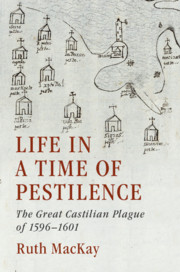Book contents
Summary
One messenger who never made it past a city wall was Francisco de Nanclares, the chief city council notary from Burgos, who in late April 1599 knocked on Valladolid’s Santa Clara gate with letters from his city about plague precautions there.1 He remained outside for two days, during which time the Valladolid city council took care of him, spending fifty-nine reales on his upkeep. The man in charge of the gate was Diego de Caranda, a member of the city council. Nanclares and his servant ate two meals a day and slept in the home of a woman who lived in the nearby countryside. They rented two beds, which were transported from an inn to the woman’s house. There was a load of hay and eight celemines of barley for their two horses. Rather than showing gratitude for this treatment, however, Burgos was shocked at the libel implicit in other cities’ hasty conclusions about its state of health. “No one anywhere will take in [people from Burgos]. Instead, they receive them with spears, insolence, ferocity, and blind ignorance as if it were true that the city is pestilent,” the aggrieved lieutenant corregidor, Francisco de Valencia, and his city’s doctors wrote to the king. They admitted that “more than” eighty people had died in the past three months; that same week the figure was raised to 120. But the disease was not true peste (“people are dying there but it’s not peste,” a recipient wrote on the cover page), and thus it was unjust for Valladolid and other places to cut off communications.2 Around a year earlier, in contrast, Valladolid had welcomed a messenger from Melgar de Fernamental, which had finally managed to be removed from the list of pestilent places. That man, named Diego González de Paredes, was allowed to enter all the towns on his route until reaching Madrid, where not only was he not allowed in, he was fined for insisting repeatedly that he had to give the Council of Castile a pile of papers about the alleged good health in his town.3
- Type
- Chapter
- Information
- Life in a Time of PestilenceThe Great Castilian Plague of 1596–1601, pp. 84 - 115Publisher: Cambridge University PressPrint publication year: 2019

